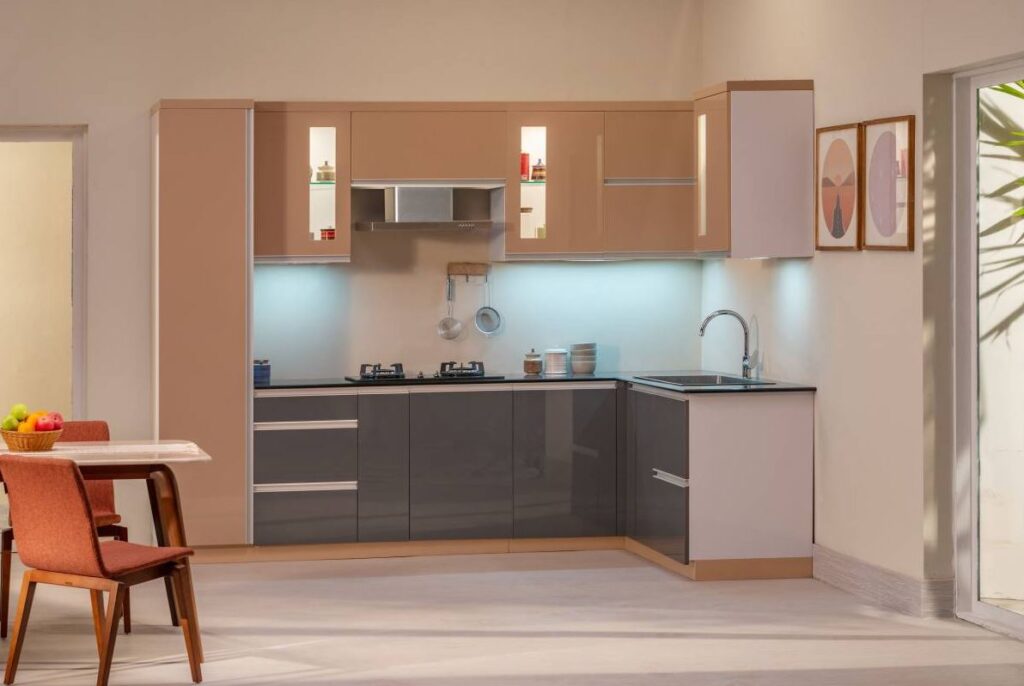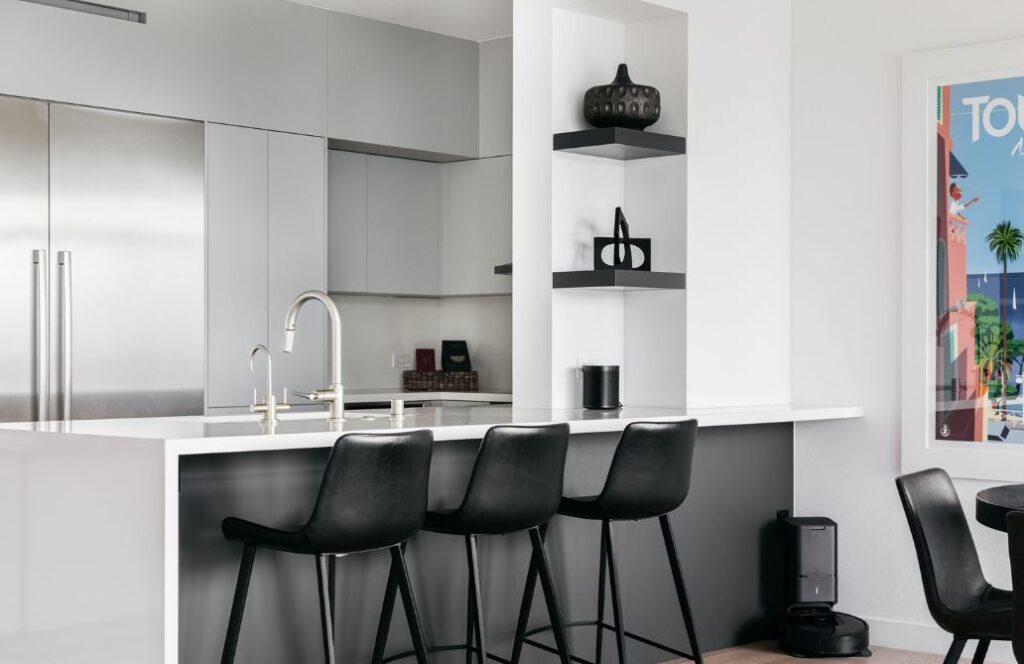The Heart of the Home: How Furniture Shapes Your Kitchen’s Personality
Often, the kitchen is more than just a space for cooking; it’s the vibrant heart of a home, a place of gathering, comfort, and creativity. But what truly brings this space to life and defines its character? The answer lies in the furniture we choose.
In this blog post, we will delve into how your kitchen furniture selection can significantly impact this central space’s ambience and functionality. From historical shifts in kitchen design to the evolution of furniture from mere utility to a blend of style and practicality, we’ll explore every aspect. Whether you’re looking to revamp your kitchen or just seeking inspiration, this journey will guide you in choosing pieces that meet your practical needs and resonate with your style and the soul of your home. Join us as we uncover the secrets to making your kitchen a true reflection of your personality through the art of furniture selection.

Historical Perspective
The kitchen, often hailed as the heart of the home, has undergone a remarkable transformation over the centuries. In ancient times, kitchens were rudimentary, centred around a hearth or fireplace. Furniture was minimal, often just a simple table and rudimentary seating. As we moved into the Middle Ages, the kitchen’s function remained utilitarian, with large open fireplaces dominating the space, around which basic wooden tables and benches were arranged.
The Industrial Revolution brought about significant changes. With advancements in technology and the availability of new materials, kitchen design began to evolve. The late 19th and early 20th centuries saw the introduction of built-in cabinetry and more refined furniture. This era marked the beginning of considering kitchen design aesthetics, though functionality remained paramount.
The real transformation in kitchen furniture began in the 20th century, especially post-World War II. The economic boom and technological advancements led to a rethinking of the kitchen. It was no longer just a cooking space but a living space. This shift was reflected in the furniture – stylish yet functional designs emerged. Chairs and tables became works of art, crafted to be comfortable and appealing. Once a rarity, kitchen islands became a central feature, serving as dining tables, storage units, and workspaces.
Material innovation also played a crucial role. The introduction of plastics, laminates, and engineered woods allowed for various textures, colours, and designs, allowing homeowners to personalise their kitchens like never before.
Understanding Kitchen Layouts
The layout of a kitchen significantly impacts its functionality and aesthetics. The L-shaped kitchen, characterised by countertops on two adjoining walls, is popular for its efficiency and flexibility, suitable for small and large spaces. The U-shaped layout, encompassing three walls, offers ample countertop and storage space, ideal for those who spend considerable time cooking. The galley kitchen, with two parallel units, makes the most of limited space and is a common choice in urban apartments.
In each of these layouts, furniture plays a critical role. In an L-shaped kitchen, a central island can provide additional workspace and act as a casual dining spot. The right choice of cabinets and open shelving in U-shaped kitchens can maximise storage and reduce clutter. For galley kitchens, sleek, space-saving furniture like foldable tables or integrated bench seating can enhance functionality without overcrowding the area.
Choosing the Right Furniture
Choosing kitchen furniture requires balancing several factors. Space is paramount; furniture must fit comfortably while allowing easy movement. Budget is another consideration – quality pieces are an investment, but many options offer style and durability without a hefty price tag. The kitchen’s overall style – modern, rustic, or something else – should guide the furniture choices, ensuring a cohesive look.
When selecting tables, consider shape and size relative to your space. Extendable tables are a versatile choice for smaller kitchens. Chairs should complement the table and offer comfort – after all, kitchens are often where people gather and linger. Kitchen islands, a central element in modern kitchens, should be chosen based on the kitchen’s layout and the homeowner’s needs – whether more for storage, prep work, or dining.
Kitchen furniture material is not just about looks; it’s about longevity. Solid woods, durable metals, and high-quality laminates can withstand the rigours of kitchen use. Craftsmanship is equally important. Well-constructed joints, smooth finishes, and thoughtful unique designs contribute to the furniture’s beauty and lifespan.
Color Schemes and Themes
Colour is a powerful tool in defining a kitchen’s personality. A bright, vibrant colour scheme can energise the space, while softer, neutral tones create a more calming environment. The colour of the furniture must harmonise with the overall palette of the kitchen to create a balanced and pleasing aesthetic.
For a cohesive look, furniture should complement the kitchen’s existing theme. In a rustic kitchen, for instance, wooden furniture with a natural finish enhances the warm, cosy feel. In a modern kitchen, sleek, minimalist furniture in monochrome or bold colours might be more appropriate. For those wishing to make a statement, contrasting colours can create a striking visual impact, but this should be approached cautiously to avoid overwhelming the space.
Consider colour, texture, and form when integrating furniture into a themed kitchen. For instance, a vintage-themed kitchen could be enhanced with antique-style chairs and a classic farmhouse table. At the same time, a contemporary space might benefit from furniture with clean lines and glossy finishes.
In all cases, the key is balance. The furniture should stand out enough to contribute to the kitchen’s character, but not so much that it clashes with other elements. This careful furniture selection and placement can turn a kitchen from a mere cooking area into a space that truly reflects your personal style and becomes a central, beloved part of your home.
Functional and Decorative Elements
The kitchen, being a functional space, requires smart storage solutions. Integrating storage with furniture maximises space and contributes to the kitchen’s aesthetic. Modern kitchen cabinets and shelves come in various designs, allowing open and closed storage. Open shelving can display decorative items or everyday dishes, adding personality and warmth. Islands with built-in cabinets offer an additional storage option and can keep essential tools and appliances within easy reach.
Decorative furniture pieces like a statement chair, an antique cabinet, or a unique light fixture can add a touch of personality to your kitchen. These pieces serve as focal points and can reflect your style, whether vintage, rustic, or contemporary. Smaller items like bar stools or distinctive chairs around a breakfast nook can significantly impact.
Personalising Your Space
Personalising your kitchen can be as simple as choosing furniture that reflect your story or style. Consider furniture with personal significance, like a family heirloom table or chairs sourced from a local artisan. Customising pieces, such as painting a cabinet in your favourite colour or reupholstering chairs with a unique fabric, can also add a personal touch.

Unique finds, such as a custom-built island made from reclaimed wood or a bespoke dining table, can serve as a centrepiece in your kitchen. These pieces personalise the space and often come with a story, adding depth and character to your home.
The Psychological Impact of Kitchen Furniture
The aesthetics of kitchen furniture can significantly impact the mood and atmosphere of the space. Colours, textures, and designs can evoke different feelings. For example, warm wood tones create a cosy, inviting environment, while sleek, minimalistic designs foster calm and order.
Ergonomics in furniture design is crucial for comfort and well-being. Chairs and tables at the right height, kitchen counters that are easy to work at without straining, and well-placed handles and knobs all contribute to a more comfortable and efficient kitchen experience.
Sustainability and Eco-Friendly Choices
Sustainability is increasingly important in kitchen design. Eco-friendly furniture options include pieces made from recycled or sustainably sourced materials. Bamboo, reclaimed wood, and recycled metal are popular, environmentally friendly but also durable, and stylish choices.
Investing in sustainable kitchen furniture is good for the environment and your home in the long run. These pieces often come with greater durability and timeless designs, ensuring your kitchen remains functional and fashionable for years.
In this journey through the world of kitchen furniture, we’ve explored the historical evolution of kitchen design, the importance of layout and functionality, the impact of colour and personalisation, and the role of furniture in creating a kitchen that is not just a cooking space but a reflection of your personality.
We encourage you to experiment with different styles, layouts, and pieces to find what best suits your space and taste. Remember, your kitchen is the heart of your home, and with the right furniture, it can be a source of joy, comfort, and beauty for you and your family.
Leave a Reply